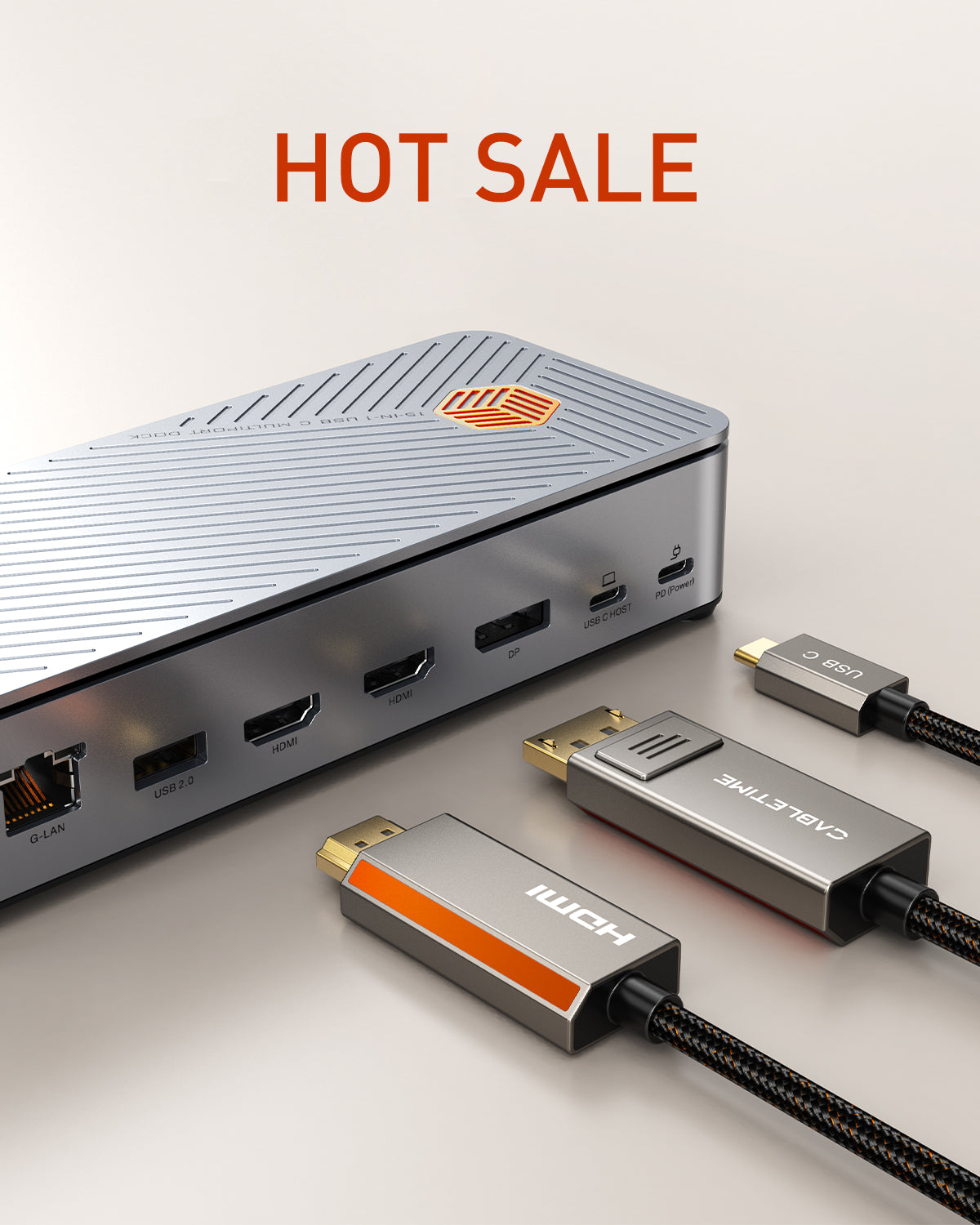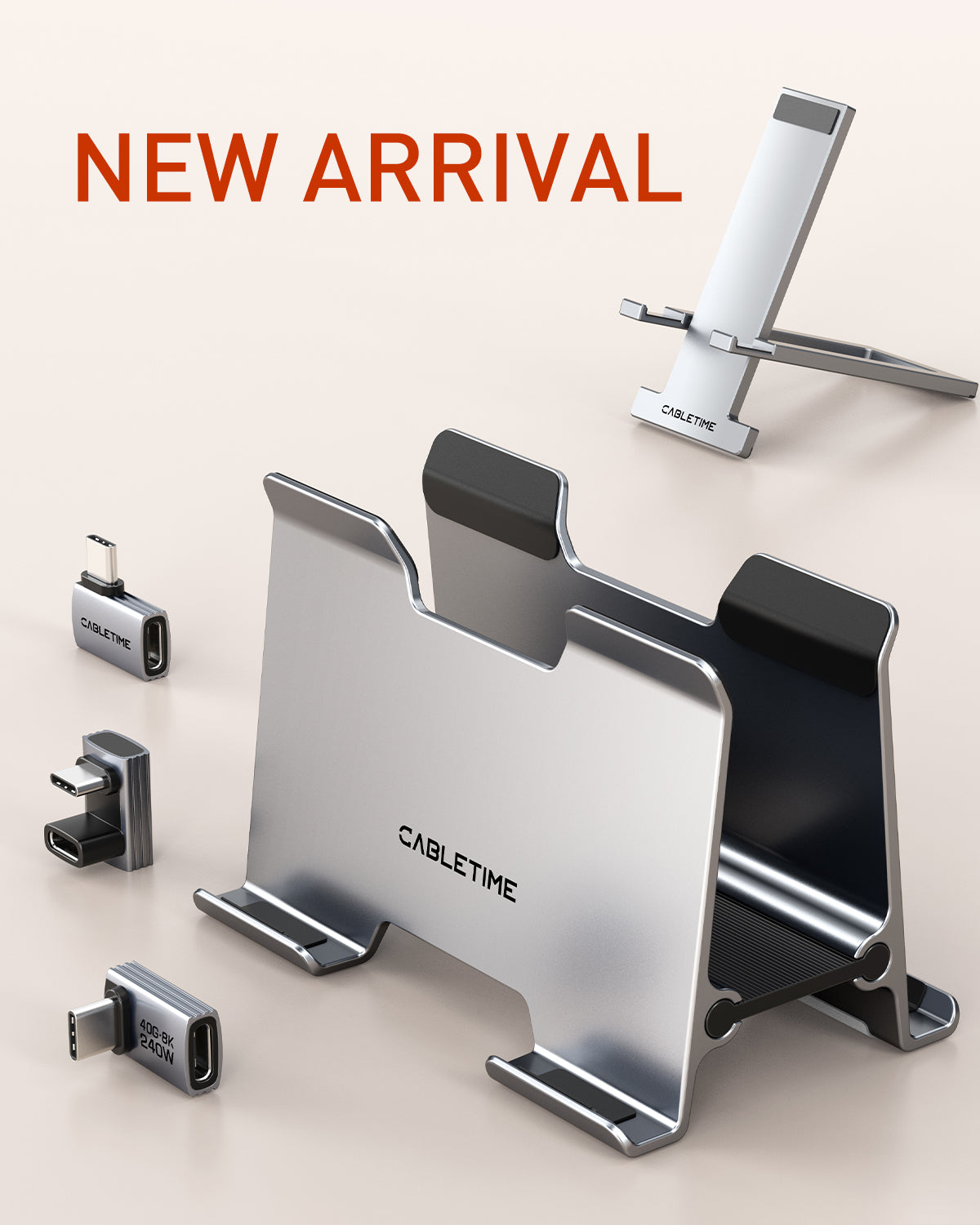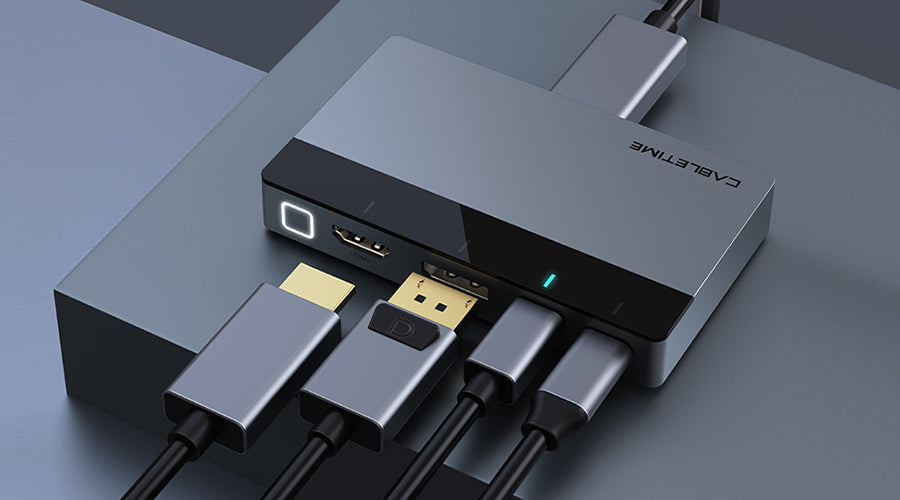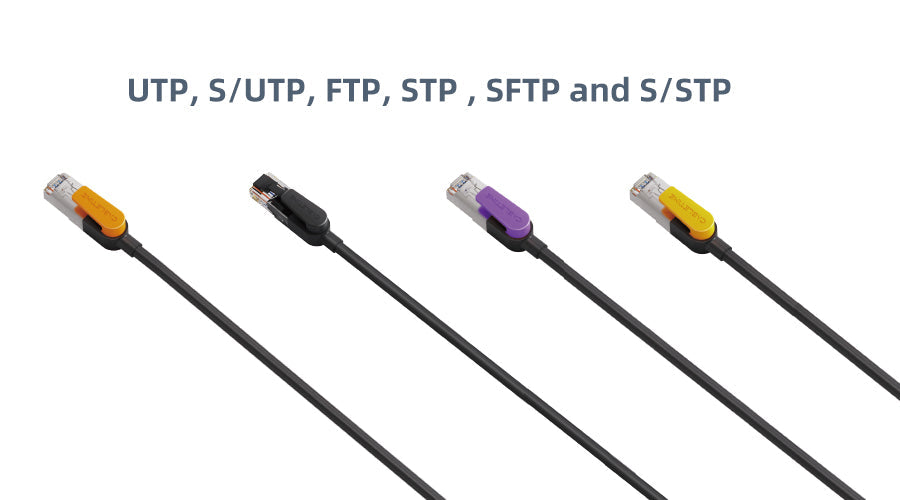Wünschen Sie sich, Ihr Fernseher hätte mehr HDMI-Anschlüsse zum Anschluss all Ihrer Geräte? HDMI-Umschalter bieten eine einfache und kostengünstige Möglichkeit, zusätzliche HDMI-Eingänge hinzuzufügen.
In diesem umfassenden Leitfaden erklären wir Ihnen alles Wissenswerte über HDMI-Umschalter – von der Funktionsweise über Tipps zur Einrichtung bis hin zur Lösung häufiger Probleme. Lesen Sie weiter und erfahren Sie, wie diese praktischen Gadgets Ihr Home-Entertainment-System vereinfachen.
Inhaltsverzeichnis
Was ist ein HDMI-Umschalter?
Ein HDMI-Umschalter, auch HDMI-Selektor genannt, ist ein Gerät, mit dem Sie mehrere HDMI-Quellgeräte an ein Display mit begrenzten HDMI-Anschlüssen anschließen können.
Wenn Ihr Fernseher beispielsweise nur über zwei oder drei HDMI-Eingänge verfügt, Sie aber einen Kabelreceiver, einen Blu-ray-Player, eine Spielekonsole, einen Streaming-Stick und mehr anschließen möchten, ist ein HDMI-Umschalter die Lösung.
Hier ist eine kurze Analogie:
Ein HDMI-Umschalter fungiert als Operator in einer herkömmlichen Telefonzentrale und ermöglicht Ihnen das manuelle oder automatische Umschalten zwischen verschiedenen Geräten, die an ein einzelnes Ausgabedisplay angeschlossen sind.
Indem Sie alle Ihre HDMI-Geräte an den Umschalter anschließen und den Umschalter mit dem HDMI-Anschluss Ihres Fernsehers verbinden, können Sie mithilfe der Tasten an der Umschalterbox selbst oder der mitgelieferten Infrarot-Fernbedienung (IR) einfach zwischen ihnen umschalten.
Zu den wichtigsten Vorteilen von HDMI-Umschaltern gehören:
- Fügt zusätzliche HDMI-Anschlüsse zum Anschluss mehrerer Geräte hinzu
- Ermöglicht das Umschalten zwischen HDMI-Quellen auf einem einzigen Display
- Kompakte und kostengünstige Möglichkeit zur Erweiterung von HDMI-Anschlüssen
- Verfügbar mit IR-Fernbedienung und automatischen Umschaltfunktionen
Wenn Sie also keinen Platz mehr haben, um Ihre HDMI-Geräte anzuschließen, können Sie mit einem Umschalter alle Geräte über einen zentralen Hub verbinden.
Arten von HDMI-Umschaltern
Es stehen verschiedene Arten von HDMI-Umschaltern zur Verfügung:
Manuelle HDMI-Umschalter
Wie der Name schon sagt, müssen Sie bei manuellen HDMI-Umschaltern eine Taste am Gerät drücken, um zwischen verschiedenen angeschlossenen Geräten umzuschalten. So können Sie den gewünschten HDMI-Eingang manuell auswählen.

Durch die manuelle Umschaltung haben Sie die direkte Kontrolle über Ihren HDMI-Eingang, dies kann jedoch weniger praktisch sein als automatisierte Optionen.
Automatische HDMI-Umschalter
Automatische oder „auto-switching“ HDMI-Umschalter erkennen, wenn ein angeschlossenes Gerät aktiv wird und wechseln automatisch zu diesem Eingang.
Wenn Sie beispielsweise Ihren Blu-ray-Player einschalten, erkennt der automatische HDMI-Umschalter das Signal und wechselt zum Blu-ray-Eingang, ohne dass Sie eine Taste drücken müssen. Das ermöglicht einen nahtlosen Wechsel.

Die automatische Umschaltung kann praktisch sein, ermöglicht Ihnen jedoch keine manuelle Kontrolle zur direkten Auswahl von Eingängen.
HDMI-Umschalter mit Fernbedienung
Viele HDMI-Umschalter werden mit IR-Fernbedienungen (Infrarot) geliefert. So können Sie bequem aus der Ferne zwischen HDMI-Geräteeingängen wählen.
HDMI-Umschalter mit Fernbedienung kombinieren den Komfort manuellen Umschaltens mit der Steuerung aus der Ferne, um nahtlos zwischen Mediaplayern, Kabelboxen, Konsolen und anderen Geräten zu wechseln.
Zusammenfassend lässt sich also sagen, dass Sie manuelle Tasten am Gerät selbst, eine automatische Eingangserkennung und Fernbedienungen zur Auswahl Ihrer HDMI-Quellgeräte haben.
So richten Sie einen HDMI-Umschalter ein
Die Installation und Einrichtung eines HDMI-Umschalters zum Hinzufügen weiterer Geräteanschlüsse ist schnell und einfach. Befolgen Sie einfach diese Schritte:

Schritt 1: Geräte mit dem Switcher verbinden
Schließen Sie Ihre HDMI-Quellgeräte wie Media-Streamer, Kabelboxen, Blu-ray-Geräte und Spielesysteme mithilfe von HDMI-Kabeln an die Eingangsanschlüsse des Umschalters an.
Stellen Sie sicher, dass alle Geräte, die Sie anschließen möchten, zuerst ausgeschaltet sind, wenn Sie Kabel anschließen.
Schritt 2: Switcher mit dem Fernseher verbinden
Verbinden Sie den Ausgang des Umschalters über ein HDMI-Kabel mit einem freien HDMI-Anschluss Ihres Fernsehers. Der Umschalter fungiert nun als Hub, der Medien von Ihren zahlreichen Geräten zum Fernseher überträgt.
Schritt 3: Eingänge wechseln und genießen
Bei manuellen HDMI-Umschaltern drücken Sie die Taste am Gerät, die dem gewünschten Geräteeingang entspricht. Die Tastenleuchten zeigen an, welches Gerät aktiv ist.
Bei automatischen Umschaltern schalten Sie einfach das Quellgerät ein, das Sie ansehen möchten. Der Umschalter erkennt den Eingang automatisch und wechselt zu diesem.
Alternativ können Sie mit der mitgelieferten Fernbedienung bequem von der Couch aus Eingänge auswählen und wechseln.
Nach dem Umschalten zeigt Ihr Fernseher den Medien-Feed des ausgewählten Geräts an, das an die HDMI-Umschaltbox angeschlossen ist. Lehnen Sie sich entspannt zurück und genießen Sie Ihr komplettes Entertainment-Setup.
Und das ist schon alles! Mit nur einem HDMI-Umschalter können Sie problemlos eine Vielzahl von Geräten an einen Fernseher mit begrenzten Anschlüssen anschließen.
Häufige Probleme und deren Lösung
Obwohl HDMI-Umschalter im Allgemeinen zuverlässig sind, kann es bei der Einrichtung und Nutzung zu Problemen kommen. Hier sind einige der häufigsten Probleme beim HDMI-Umschalten und deren Lösung:
Kein Signal oder schwaches Signal nach dem Anschließen des Umschalters
Wenn Ihr Fernsehbildschirm nach der Installation eines HDMI-Umschalters kein Signal oder ein flimmerndes/instabiles Video anzeigt, liegt möglicherweise ein loses HDMI-Kabel oder ein Problem mit der Anschlusskompatibilität vor.
- Lösung:Überprüfen Sie, ob alle HDMI-Kabel, die die Geräte mit dem Umschalter und den Umschalter mit dem Fernseher verbinden, fest eingesteckt sind. Stellen Sie außerdem sicher, dass die Kabel nicht beschädigt oder fehlerhaft sind.
- Versuchen Sie, wenn möglich, auf kürzere oder hochwertigere HDMI-Kabel umzusteigen, um das Signal zu verstärken.
- Stellen Sie sicher, dass der Umschalter die in den Spezifikationen angegebene Videoauflösung/Bildwiederholfrequenz Ihrer Quellgeräte verarbeiten kann. Bei 4K-HDR-Geräten muss der Umschalter außerdem unterstützt 4K/60fps.
Die automatische Umschaltung funktioniert nicht richtig
Bei einigen automatischen HDMI-Umschaltern können Probleme mit der automatischen Eingangserkennung auftreten:
- Lösung:Deaktivieren Sie zunächst die automatische Umschaltfunktion und verwenden Sie stattdessen die manuellen Tasten oder die Fernbedienung, um die Ports direkt umzuschalten. Die automatische Umschaltung ist beim Arbeiten praktisch, kann aber zu Störungen führen.
- Überprüfen Sie außerdem, ob die angeschlossenen Geräte eingeschaltet sind und ein Videosignal übertragen, um die automatische Umschaltung beim Einschalten auszulösen. Wenn Geräte nicht immer erkannt werden, ist eine manuelle Steuerung wahrscheinlich besser.
Die Switcher-Fernbedienung funktioniert nicht
Wenn die mitgelieferte IR-Fernbedienung die Ports nicht richtig umschaltet oder nur zeitweise funktioniert, liegt wahrscheinlich ein Sichtverbindungsproblem vor:
- Lösung:Stellen Sie sicher, dass der IR-Empfänger am Umschalter von der Stelle aus, auf die Sie die Fernbedienung richten, gut sichtbar ist. IR-Fernbedienungen erfordern eine direkte Sichtverbindung.
- Um die Zuverlässigkeit zu verbessern, gehen Sie näher an den Umschalter heran oder richten Sie das Mobilteil direkter auf das IR-Sensorauge. Sollten die Probleme weiterhin bestehen, sollten Sie eine Bluetooth-Fernbedienung verwenden, um die drahtlose Steuerung aus jedem Raumwinkel zu vereinfachen.
HDMI-Umschalter verursacht Probleme bei der Video-/Audiosynchronisierung
In seltenen Fällen kann es nach der Übertragung von Geräten über einen HDMI-Switch zu einer Latenz zwischen Video- und Audiosignalen kommen. Diese Synchronisierungsverzögerung ist in der Regel nicht gefährlich, sondern nur ärgerlich.
- Lösung:Rüsten Sie zwischen Umschalter und Display auf hochwertigere, 48-Gbit/s-zertifizierte HDMI-Kabel auf, da Kabel mit geringerer Geschwindigkeit das Timing stören können.
- Alternativ können Sie versuchen, das Gerät direkt an den HDMI-Anschluss des Fernsehers anzuschließen, um festzustellen, ob die Umschaltbox tatsächlich die Ursache ist. Wechseln Sie zu einem anderen, für Ihre Videoauflösung zertifizierten Umschaltgerät, falls beim Weiterleiten über dieses Gerät weiterhin Synchronisierungsprobleme auftreten.
Mit sorgfältiger Gerätekompatibilität und hochwertigen Kabeln für stabile Verbindungen sollte ein HDMI-Umschalter zuverlässig funktionieren und alle Ihre HDMI-Geräte nahtlos übertragen. Sollten dennoch Probleme auftreten, helfen Ihnen die oben genannten Tipps zur Fehlerbehebung.
| Ausgabe | Mögliche Ursache | Lösung |
| Kein Signal oder schwaches Signal | Lose HDMI-Verbindungen, beschädigte Kabel, inkompatible Videoauflösung | Überprüfen Sie die Kabel. Aktualisieren Sie die Kabel. Stellen Sie sicher, dass der Umschalter die Geräteauflösungen unterstützt. |
| Automatische Umschaltung funktioniert nicht | Das Gerät schaltet sich nicht richtig ein oder überträgt kein Signal | Deaktivieren Sie die automatische Umschaltung. Verwenden Sie stattdessen die manuelle Umschaltung. |
| Fernbedienung funktioniert nicht | Problem mit der Sichtlinie des IR-Sensors | Richten Sie die Fernbedienung neu auf den IR-Empfänger. Gehen Sie näher heran. Erwägen Sie eine Bluetooth-Fernbedienung. |
| Probleme mit der Audio-/Videosynchronisierung | HDMI-Kabel von geringerer Qualität, Switcher kann die Auflösung nicht verarbeiten | Kabel aufrüsten; Gerät direkt an den Fernseher anschließen; Umschalter wechseln |
Kauftipps für HDMI-Umschalter
Beachten Sie beim Kauf des besten HDMI-Umschalters für Ihre Anforderungen und Ihr Setup diese praktischen Tipps:

Erforderliche Auflösungen anpassen
Stellen Sie sicher, dass der von Ihnen ausgewählte Umschalter die Weiterleitung der Videoauflösungen und Bildraten unterstützt, die Ihre angeschlossenen Geräte benötigen:
- Für 1080p Full HD-Geräte reicht ein einfacher HDMI-Switch
- Wählen Sie für 4K Ultra HD-Displays einen 4K/30- oder 4K/60fps-HDMI-Switch
- HDR10- und Dolby Vision-Inhalte benötigen außerdem einen kompatiblen Switch
Aus Gründen der Zukunftssicherheit ist es völlig in Ordnung, einen Umschalter zu kaufen, der eine höhere Leistung bietet als die tatsächliche Auflösung Ihres Geräts.
Berücksichtigen Sie den Bedarf an automatischer Umschaltung
Wenn Sie automatisiertes, freihändiges Umschalten zwischen Geräten bevorzugen, sollten Sie gezielt nach HDMI-Auto-Switchern suchen. Überprüfen Sie die Produktbeschreibungen auf Details zur Auto-Switching-Funktion, um das passende Automatisierungsverhalten zu finden.
Rein manuelle Umschalter bieten direkte Benutzerkontrolle, was manche Käufer bevorzugen, während intelligente automatische Umschalter mehr Komfort bieten. Berücksichtigen Sie bei Ihrer Entscheidung Ihre Präferenzen.
Wählen Sie die richtige Anzahl an Ports
Berücksichtigen Sie bei der Auswahl eines Switches, wie viele HDMI-Quellgeräte Sie jetzt und in naher Zukunft anschließen müssen. Die meisten HDMI-Switches unterstützen 2, 3 oder 4 Eingänge. Für große Home-Entertainment-Systeme gibt es jedoch auch Switches mit 8, 10 oder mehr Ports.
Wenn Sie zusätzlich zu Ihrer aktuellen Geräteanzahl ein oder zwei zusätzliche Anschlüsse haben, können Sie den tollen neuen Media-Streamer flexibel hinzufügen, wenn er Ihnen ins Auge fällt.
Zusätzliche Kompatibilitäts-Checkliste
Scannen Sie die technischen Daten des Umschalters, um die Kompatibilität mit anderer Heimkinoausrüstung wie AV-Receivern, Soundbars und spezifischen Konsolenspielanforderungen zu überprüfen:
- HDMI ARC-Unterstützung:Gewährleistet die Kompatibilität des Audio Return Channel
- CEC-Funktionalität: Zur Steuerung anderer Geräte über die TV-Fernbedienung
- 3D-Videokompatibilität:Für 3D Blu-ray Filme
- HDR und Dolby Vision:Für HDR10 und erweiterte HDR-Formatumschaltung
- Geringe Eingangsverzögerung:Unverzichtbar für Großbildkonsolen-/PC-Gamer
Fazit Übersicht
In diesem umfassenden Handbuch haben wir die Besonderheiten von HDMI-Umschaltern erkundet und detailliert beschrieben, was sie sind, wie sie funktionieren, Ratschläge zur Einrichtung und Fehlerbehebung geben, Kaufüberlegungen enthalten und vieles mehr.
Fazit: Mit HDMI-Umschaltern können Sie problemlos mehrere Unterhaltungsgeräte anschließen und zwischen deren Medienfeeds auf Fernsehern mit begrenzten HDMI-Anschlüssen umschalten. Diese flexible Konnektivität bietet ein kompaktes und preisgünstiges Design.
Wenn Sie also keine freien HDMI-Eingänge mehr für den Anschluss neuer Geräte in Ihrem Heimkino oder Ihrer Gaming-Ecke haben, ist ein HDMI-Wahlschalter die Rettung! Mit den praktischen Tipps in diesem Handbuch schließen Sie alle Geräte schnell an und können Streams wie ein Heim-AV-Profi umschalten.
Jetzt ist es an der Zeit, sich mit aufeinanderfolgenden Episoden von Ihrem Lieblings-Streaming-Dienst zu entspannen, den Sie dank Ihres schicken neuen HDMI-Umschaltbox. Genießen!
Häufig gestellte Fragen
F: Was ist der Unterschied zwischen einem HDMI-Splitter und einem HDMI-Umschalter?
A: Ein HDMI-Splitter dupliziert das Signal einer einzelnen Eingangsquelle auf mehrere HDMI-Ausgänge, um Inhalte auf mehreren Bildschirmen anzuzeigen. Mit einem HDMI-Umschalter können Sie über einen einzigen Ausgang zwischen mehreren HDMI-Eingangsgeräten umschalten und jeweils eine ausgewählte Quelle anzeigen.
F: Kann die Verwendung eines HDMI-Umschalters die Bild- oder Audioqualität beeinträchtigen?
A: Minimale Auswirkungen sind normalerweise möglich, können aber bei Umschaltern geringerer Qualität auftreten. Um Störungen oder Signalverluste zu vermeiden, verwenden Sie kurze Highspeed-HDMI-Kabel und Umschaltermodelle, die den Auflösungsanforderungen Ihres Geräts entsprechen, z. B. 4K/60 Hz.
F: Unterstützen alle HDMI-Umschalter die neuesten Standards wie 4K und HDR?
A: Nein – überprüfen Sie immer die technischen Daten. Einfache 1080p-HDMI-Switches verarbeiten keine 4K- oder HDR-Signale. Stellen Sie sicher, dass jeder Switch die Kompatibilität mit 4K, HDR10/Dolby Vision, HDMI 2.1 usw. entsprechend den Anforderungen Ihres Mediengeräts explizit angibt.
F: Wie viele HDMI-Geräte können Sie über eine einzelne Umschaltbox anschließen?
A: Die Auswahl reicht von einfachen 2-Port-Modellen bis hin zu industriellen Umschaltern mit 10, 12 oder sogar mehr Ports. Am häufigsten werden für den Heimgebrauch HDMI-Switche mit 4 oder 5 Ports verwendet, um typische Unterhaltungsgeräte anzubinden und bei Bedarf später noch ein oder zwei Geräte hinzuzufügen.
F: Kann ich einen HDMI-Switch verwenden, um meine Spielkonsole und Soundbar anzuschließen?
Ja, das ist absolut möglich. HDMI-Umschalter sind speziell für die Verbindung mehrerer Unterhaltungsmediengeräte wie Spielekonsolen, Streaming-Boxen, Blu-ray-Player und sogar Soundbars oder Lautsprecher mit HDMI-Ein-/Ausgang konzipiert. Stellen Sie einfach sicher, dass der Umschalter den erforderlichen Spezifikationen entspricht.






Hinterlasse einen Kommentar
Diese Website ist durch hCaptcha geschützt und es gelten die allgemeinen Geschäftsbedingungen und Datenschutzbestimmungen von hCaptcha.